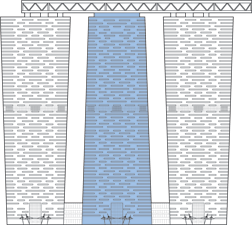Filter by
You must be a CTBUH Member to view this resource.

The Gate Residential Tower 2
The Gate District Towers
Building
Completed
2013
Residential
All-Concrete
238 m / 781 ft
66
3
832
4713
6
7 m/s
You must be a CTBUH Member to view this resource.
You must be a CTBUH Member to view this resource.
Proposed
Construction Start
Completed
The Peer Review Engineer traditionally comments on the information produced by another party, and to render second opinions, but not to initiate what the design looks like from the start.
The CTBUH lists a project manager when a specific firm has been commissioned to oversee this aspect of a tall building’s design/construction. When the project management efforts are handled by the developer, main contract, or architect, this field will be omitted.
Other Consultant refers to other organizations which provided significant consultation services for a building project (e.g. wind consultants, environmental consultants, fire and life safety consultants, etc).
These are firms that consult on the design of a building's façade. May often be referred to as "Cladding," "Envelope," "Exterior Wall," or "Curtain Wall" Consultant, however, for consistency CTBUH uses the term "Façade Consultant" exclusively.
Material Supplier refers to organizations which supplied significant systems/materials for a building project (e.g. elevator suppliers, facade suppliers, etc).
You must be a CTBUH Member to view this resource.
Usually involved in the front end design, with a "typical" condition being that of a leadership role through either Schematic Design or Design Development, and then a monitoring role through the CD and CA phases.
Usually takes on the balance of the architectural effort not executed by the "Design Architect," typically responsible for the construction documents, conforming to local codes, etc. May often be referred to as "Executive," "Associate," or "Local" Architect, however, for consistency CTBUH uses the term "Architect of Record" exclusively.
The Design Engineer is usually involved in the front end design, typically taking the leadership role in the Schematic Design and Design Development, and then a monitoring role through the CD and CA phases.
The Peer Review Engineer traditionally comments on the information produced by another party, and to render second opinions, but not to initiate what the design looks like from the start.
The Design Engineer is usually involved in the front end design, typically taking the leadership role in the Schematic Design and Design Development, and then a monitoring role through the CD and CA phases.
The CTBUH lists a project manager when a specific firm has been commissioned to oversee this aspect of a tall building’s design/construction. When the project management efforts are handled by the developer, main contract, or architect, this field will be omitted.
The main contractor is the supervisory contractor of all construction work on a project, management of sub-contractors and vendors, etc. May be referred to as "Construction Manager," however, for consistency CTBUH uses the term "Main Contractor" exclusively.
Other Consultant refers to other organizations which provided significant consultation services for a building project (e.g. wind consultants, environmental consultants, fire and life safety consultants, etc).
These are firms that consult on the design of a building's façade. May often be referred to as "Cladding," "Envelope," "Exterior Wall," or "Curtain Wall" Consultant, however, for consistency CTBUH uses the term "Façade Consultant" exclusively.
Material Supplier refers to organizations which supplied significant systems/materials for a building project (e.g. elevator suppliers, facade suppliers, etc).
23 March 2014 - Event
9 March 2014 - Event

07 November 2013 | Abu Dhabi
The Gate Towers allude to a future in which tall buildings appear at such density that many of the amenities of urban habitat on the...

14 November 2013
Gurjit Singh & Hossam Eldin Elsouefi, Aldar Properties; Peter Brannan, Arquitectonica
The Gateway forms the entrance to one of the Middle East’s largest developments. The developer, Aldar, set forth a challenge: create an unmistakable introduction to...
The Gate Towers consist of a series of towers that act as pillars beneath a curving lintel. This renders the effect of a monumental portal that defines the threshold to the Shams Abu Dhabi district, a newly-created land mass formed as an extension of the Central Business District on exposed tidal sands within a fringe of mangroves at approximately five to seven meters above sea level. The area is gradually developing at a high density and growing in prominence.
From a development standpoint, the concept was derived from two maxims: First, to make a statement of intent which is visible from the main part of the city; second, to form a gateway to the remaining sites within the Shams Abu Dhabi precinct on Reem Island.
This mixed-use residential project has a total of 3,533 luxury residential apartments in three towers of 66 stories, connected at their top with a two-level sky-bridge structure, which contains 21 large luxury penthouses. This composition is adjoined by a 22-story, horseshoe-shaped building. The complex includes three swimming pools and four water features, with car parking in 3 subterranean, one grade and three podium levels. The podium includes two levels of retail shopping mall space.
The Capping Bridge across the towers is an extraordinary achievement, involving precise calculation and steel fabrication. The two 750 metric-ton spans between the towers were fabricated on the ground and vertically strand-jacked into position 238 meters up -- the heaviest and highest lifts ever attempted for a real estate project. The cantilevered portion on the East Tower (tower 5) was an act of precision using smaller truss modules installed by a traveling gantry above.
The Dubai rope-access company Megarme installed an innovative system of tension cables to provide an underside working platform for installing soffit panels and abseiling (rappelling) hooks. Tension cables were strung between two towers at three-meter centers, with periodic connections into the structure above, and nylon nets were stretched between them. This was the fastest way to achieve a platform 230 meters in the air.
The Arc (Tower 7) has a hanging garden feature, which brings small secluded pockets of landscape up to the residential levels of the building. There are 14 hanging gardens in total, each accessible from the adjacent corridor with its own irrigation system, fountains and stepped seats.
Environmental effects such as air quality, ozone depletion and global warming were addressed in the design and were a guiding factor in the selection and installation of the mechanical and electrical equipment, which featured bi-polar filters and pre-cooling on the fresh air handling units, which improved indoor air quality and movement while controlling the temperature throughout the building.
The cooling provisions for the building are provided by a centralized district cooling plant, which serves all the towers and podium, reducing energy consumption compared to conventional systems of chillers installed individually on each of the towers.
The tower lifts are gearless traction machines using Permanent Magnet Synchronous Motor technology which reduces energy consumption by 50 percent, when compared with conventional rope-lifted machines.

07 November 2013 | Abu Dhabi
The Gate Towers allude to a future in which tall buildings appear at such density that many of the amenities of urban habitat on the...

07 November 2013 | Abu Dhabi
Gurjit Singh, Chief Development Officer of Aldar Properties, speaks about The Gate Towers in Abu Dhabi, a Finalist for Best Tall Building Middle East and...
27 March 2014
Georges Binder, Belgium Country Leader, recently joined with Executive Master Immobilier to conduct a study trip on tall buildings to the United Arab Emirates.
Subscribe below to receive periodic updates from CTBUH on the latest Tall Building and Urban news and CTBUH initiatives, including our monthly newsletter. Fields with a red asterisk (*) next to them are required.
View our privacy policy